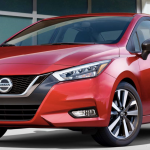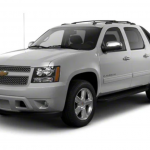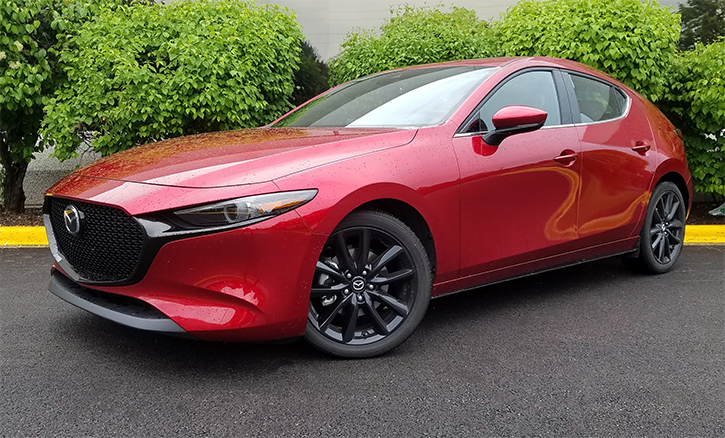
 2019 Mazda 3 Hatchback Premium AWD
2019 Mazda 3 Hatchback Premium AWD
Class: Compact Car
Miles driven: 549
Fuel used: 19.0 gallons
Real-world fuel economy: 28.9 mpg
| CG Report Card | |
|---|---|
| Room and Comfort | C+ |
| Power and Performance | B+ |
| Fit and Finish | A |
| Fuel Economy | B |
| Value | B+ |
| Report-card grades are derived from a consensus of test-driver evaluations. All grades are versus other vehicles in the same class. Value grade is for specific trim level evaluated, and may not reflect Consumer Guide's impressions of the entire model lineup. | |
| Big & Tall Comfort | |
| Big Guy | B |
| Tall Guy | B- |
| Big & Tall comfort ratings are for front seats only. "Big" rating based on male tester weighing approximately 350 pounds, "Tall" rating based on 6'6"-tall male tester. | |
| Drivetrain | |
| Engine Specs | 186-hp 2.5L |
| Engine Type | 4-cylinder |
| Transmission | 6-speed automatic |
| Drive Wheels | AWD |
Driving mix: 70% city, 30% highway
EPA-estimated fuel economy: 24/32/27 (city/highway/combined)
Fuel type: Regular Gas
Base price: $28,900 (not including $920 destination charge)
Options on test car: Cargo mat ($90), all-weather floor mats ($125), illuminated door-sill plates ($425), Soul Red Crystal paint ($595), auto-dimming mirror ($275), navigation SD card ($450), wireless device charging ($275)
Price as tested: $32,055
Quick Hits
The great: Crisp handling; high-class interior trimmings
The good: Fuel economy; available features
The not so good: Compromised rear visibility; tight rear-seat space; sticker prices have gone up with redesign; not all testers like console-mounted infotainment control system
More Mazda 3 price and availability information
John Biel
Here are three things to know about the 2019 Mazda 3:
- It has been restyled inside and out.
- It is newly available with all-wheel drive.
- It wants you to think it is a luxury car.
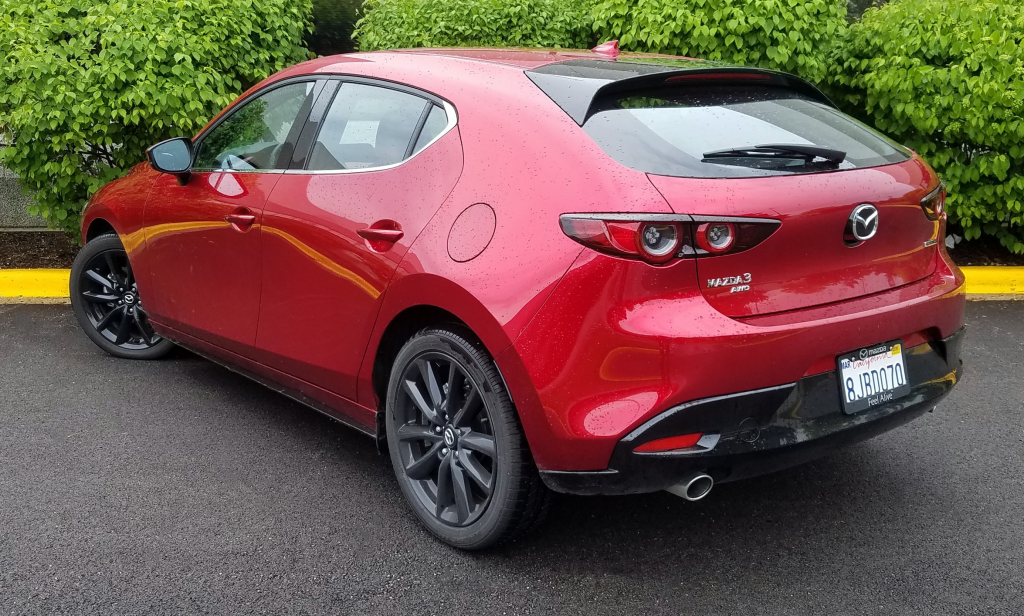
Mazda’s compact sedan and hatchback have been redone with less of the obvious sculpting that was on the bodysides of the previous generation. The chassis is reworked with a twist-beam rear axle and the aforementioned AWD option. Meanwhile, appointments and equipment—especially at the top-line Premium level—make it clear that Mazda wants to do a little social climbing.
Test Drive: 2019 Hyundai Elantra Limited
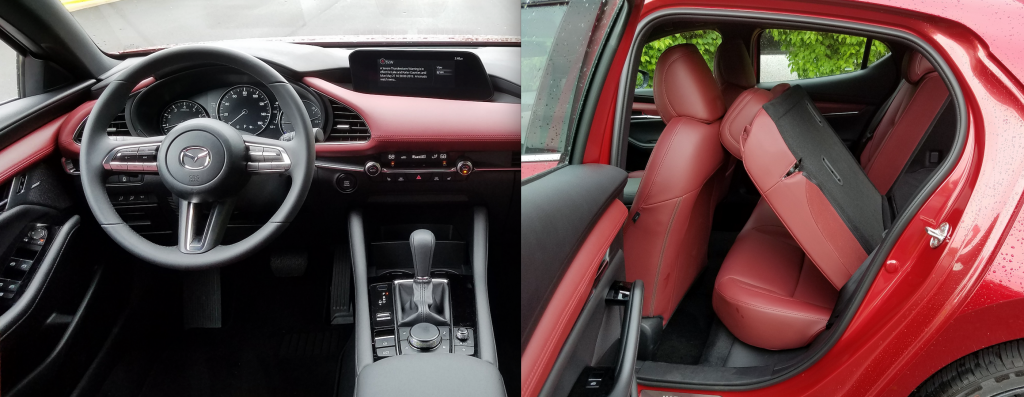
Consumer Guide tried out an all-wheel-drive hatchback with the Premium Package. (Mazda considers the various trims above the standard model to be packages. The sedan has three upgrades: Select, Preferred, and Premium. The hatch has two: Preferred and Premium.) Its base price of $29,920, with delivery, grew to $32,055 with extra-cost Soul Red Crystal paint and six other accessories. Note that a 3 with i-ACTIV all-wheel drive costs $1400 more than a comparable model with front-wheel drive.
Test Drive: 2019 Toyota Corolla Hatchback XSE
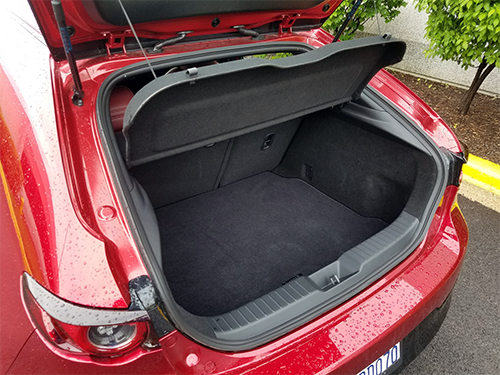
The new hind axle replaces a fully independent rear suspension, a seemingly retrograde step. However, Mazda claims it’s easier to tune the simpler suspension through its bushings than it would be to properly set up a multilink unit. (It’s probably cheaper, too.) The test car displayed a firm ride, but it absorbed bumps well, and it shook off much body lean when cornering. Standard G-Vectoring Control Plus adjusts front-to-back power delivery during cornering to heighten the driver’s sense of control. Steering trends just a little light, so most drivers should find a Mazda 3 easily maneuverable, if not exactly sport-sedan responsive.
What hasn’t changed—or at least it hadn’t in CG’s test car—is the powerteam. Though other engines may come, the 2019 model bowed with the same naturally aspirated 2.5-liter 4-cylinder engine used previously, paired with a 6-speed automatic transmission. (A 6-speed manual is solely available for the front-drive Premium hatchback.) The 186-horsepower engine generates 186 lb-ft of torque, enough of both to put up a credible show of spunk . “Sport” mode, activated by a toggle switch on the console, changes the shift pattern to wring a little more power from each gear range before upshifting, but performance remains more lively than lusty.
The 2.5 incorporates cylinder deactivation as a fuel-saving tactic. The EPA estimates that an AWD Mazda 3 should average 24 mpg in city driving, 32 mpg on the highway, and 27 mpg combined. When this tester put 114.7 miles on the car (with 69 percent city-type operation), it got 25.36 mpg.
It’s the 3’s interior that really signals Mazda’s ambition to rise above the moderately priced mass-market space that it has inhabited. Quality switchgear and well-fitted soft-surface areas are in evidence. Lids and panels for storage spaces don’t feel loose or flimsy when handled. Premium Package elements start with leather-upholstered seats (red in the test car, with matching padded leatherette on the instrument-panel facing that continued into the front doors). Also included are a head-up display, adaptive front lighting, front and rear LED accent lighting, a black finish for the standard 18-inch alloy wheels, power moonroof, and paddle shifters. That’s all in addition to more generally available items like heated front seats, a power driver’s seat with memory, leather-wrapped steering wheel and shifter knob, dual-zone automatic climate control, 12-speaker Bose audio system, radar cruise control with traffic-sensing stop and go, a cargo-area cover, LED headlights and taillights, and rain-sensing windshield wipers.
Tech touches include Apple CarPlay/Android Auto smartphone integration, keyless entry and starting, and Bluetooth phone and audio-streaming connectivity. An electronic safety net is woven from blind-spot and rear cross-traffic alerts, new driver-attention alert, lane-departure warning and lane-keeping assist, and automatic “smart” braking that—let us tell you—really works.
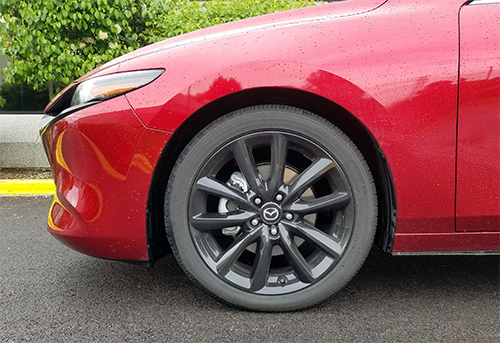
It’s too bad the same desire for simplicity that ruled the suspension engineers didn’t beat in the breasts of the interior-controls engineers. We saw this coming several years ago when the previous-generation 3 got “a twist-and-toggle dial . . . to summon audio, navigation, and other system controls” on a display screen. Even back then, yours truly was starting to get a bad feeling about this: “Circulating around the screens to select what you need is fairly easy to grasp in the Mazda—more so than in the luxury cars that seem to want to impress you by confounding you with their central-control get-ups—but this is still the first step on a slippery slope.” Well, time marches on, and today’s Commander Control is about as tricky as any unit in established luxury marques, with multiple steps needed to complete some historically easy tasks. (Who needs to work up a sweat tuning and saving radio stations?) Plus, the redesigned in-dash screen is no longer a touchscreen, so everything that appears on it has to be worked by the console-mounted control dial. At least the climate system has its own bank of temperature dials and function buttons.
Front legroom isn’t bad and headroom is fair, but a couple of average-sized adult passengers will fit in back only if the folks in front of them don’t need to track their seats far back. Driver vision is good ahead and to the sides up to the B-pilars. From there back, especially at the rear corners, the view diminishes. The glove box and console box are of modest dimensions. A single rear storage pouch is affixed to the back of the front passenger seat. Pockets are found in all four doors, and there are pairs of cup holders in the console and the pull-down rear armrest. The hatchback cargo hold is big enough for a week’s groceries or three or four pieces of luggage; bigger loads will require lowering the 60/40-split rear seats, which fold almost flat.
Mazda seems to be fashioning a new image for its small cars. Shoppers with a taste for something better than basic won’t be able to count out the Mazda 3.
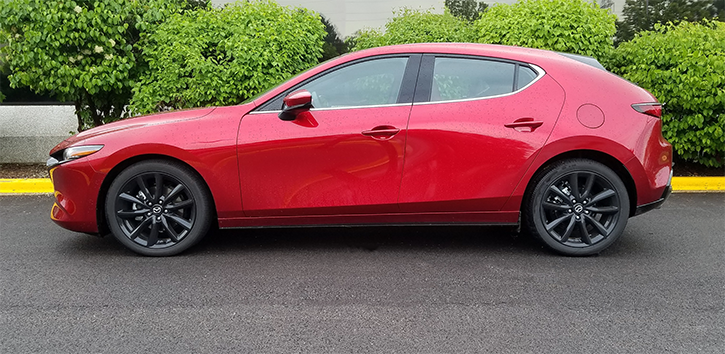
In Defense of the Sedan: A Minneapolis Family Road Trip in the 2019 Mazda 6
2019 Mazda 3 Hatchback

